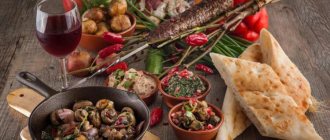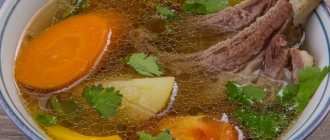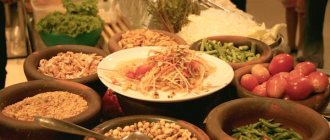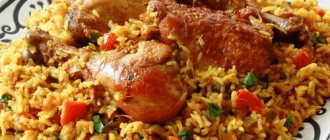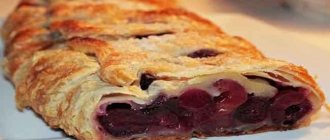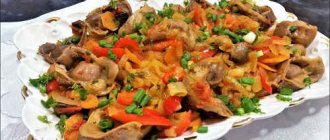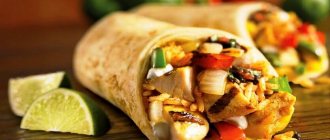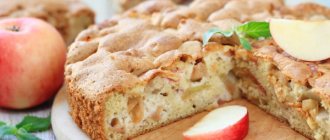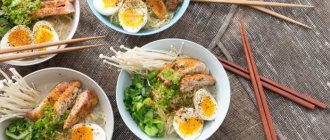Japanese cuisine is distinguished by the fact that the dishes of this cuisine are usually simple, made from a small number of ingredients. When cooking, Japanese chefs try to preserve the true taste of the product; products are usually not subjected to strong heat treatment; they prefer to eat raw, boil, stew or steam. According to Japanese eating culture, it is customary to eat several dishes in small portions, and the food is eaten immediately after preparation. In Japanese cuisine, special attention is paid to the presentation and appearance of the dish. Rice is always served, which for the Japanese is like bread for the Russians. In Japan, they wash down their food with green tea or sake. Due to the fact that the Japanese prefer to eat fresh food rather than stored food from the summer, the range of products in Japanese cuisine changes depending on the season. Due to its geographical location, seafood plays an important role in the Japanese diet.
Now in more detail about the main components of Japanese cuisine.
Soups and stews
Japanese soup or stew is usually a very filling dish. In the Land of the Rising Sun, there is a great variety of different soups with a variety of ingredients: meat, fish, vegetables or seafood. If we talk about the meal in general, then a Japanese lunch begins with stew (siu-mono). It could be:
- potato soup potetto (with or without meatballs);
- ukha (suimono, ramen);
- buckwheat noodles (sobo);
- misoshiru.
“Misoshiru” is the name given to all soups that are seasoned with miso. They are prepared at any time of the day and even before breakfast. Misoshiru is usually served with tofu, seaweed and soy omelette.
Noodles
Japanese noodles are a special product, unlike European pasta. Rice, buckwheat, and wheat are used for cooking. Ready meals are served cold or hot. Thus, soba is often made cold and consumed with soy sauce, and wheat udon is served hot. The broth in which the pasta was cooked is served separately and consumed with soy sauce.
Ramen
Ramen is a healthy and tasty Asian dish that has spread throughout the world. Main ingredients:
- noodles;
- seaweed;
- bouillon;
- vegetables;
- seasonings
The noodles are combined with broth and other ingredients and served. Often a boiled egg, cut into two slices, is added to ramen.
There is no single recipe for making ramen. The Japanese themselves divide the options by region: Hakata, Kitakata, Wakayama, Onomichi. A special variety is spicy kimchi ramen.
There are rules and order for eating ramen. First, large ingredients are eaten (sticks are used). The noodles must be sucked in, making specific squelching sounds. The broth is drunk last.
Delicious ramen
Soba
Soba is a traditional product made from buckwheat flour (often with the addition of wheat for plasticity). A special knife is used to cut the dough; the finished strips are boiled. There are varieties of soba:
- cha (with green powdered tea);
- hagi (with seaweed);
- inaka (thick noodles made from whole buckwheat grains);
- juwari (made from pure buckwheat flour);
- Sarasina (light noodles made from peeled buckwheat);
- ni-hachi (20% wheat and has symbolic meaning).
Historians believe that buckwheat has been known to the Japanese since ancient times. In 1254, the monk Dome wrote a mocking waka about Greek, and the Ruijusandaikyaku collection of laws required peasants to grow this crop. Buckwheat noodles gained popularity during the Tokugawa period. Edo is filled with cheap buckwheat establishments catering to those for whom white rice is too expensive. It turned out that consuming soba reduces the risk of beriberi.
Soba is served cold in summer and hot in winter. The chilled one is decorated with seaweed and seasoned with soba tsuyu sauce made from dashi, soy sauce and mirin. It is served hot with diluted tsuyu, often with vegetables, seaweed, batter, and shrimp.
Particularly interesting is the “moon watching dog” tsukimi. For it they use cheese and egg. The yolk is associated with the full moon, the white represents clouds. Tsukimi-soba is served during the season of enjoying the moon.
On New Year's Eve, toshikoshi is prepared - soba, symbolizing best wishes. When moving house, neighbors are given hikkoshi.
Buckwheat soba noodles
Udon
Udon is an essential, common, affordable Japanese food. It is available in most inexpensive cafes and restaurants and is known in various forms. The noodles are made from wheat flour with the addition of mineral water and salt. The culture of eating udon was adopted from China in the 14th century.
In the eastern regions of Japan, udon is served with a dark brown broth containing soy sauce. In the western part, light soy broth is popular.
Sushi (sushi)
Sushi (maki, nigiri) is most often eaten whole. As a last resort, you can use chopsticks to divide the sushi into small pieces. Women always eat sushi with chopsticks, but men are allowed to eat it with their hands. Sushi (sushi) is eaten as follows:
- soy sauce is poured into a special saucer;
- sushi is turned on its side and picked up with chopsticks;
- dip fish (not rice) in soy sauce;
- put the sushi in your mouth.
Sushi is a fairly democratic dish that has gained great popularity in many countries. For sushi, you no longer have to go to a Japanese restaurant; you can order sushi at home in TOKYO CITY restaurants and enjoy dishes made from fresh ingredients at the most affordable prices.
Rice dishes
The most famous recipes in our country for classic Japanese cuisine are with rice. On average, a Japanese eats rice 2-3 times a day; often without seasoning, in small portions. It is believed that such food maintains health. In addition to main dishes, rice is used to prepare alcoholic drinks - beer, sake, sethu. Rice sake aged for decades reaches a strength of 18 degrees and tastes similar to sherry. Sethu is like vodka.
Onigiri
The national rice dish is onigiri (rice balls with filling). These are convenient portions, quickly fill you up and are suitable as a snack. Since the bulk of the ball is rice, each serving contains a lot of carbohydrates. Thanks to this, onigiri is a popular snack that is taken for lunch at work, school, or on a trip. Anyone can try onigiri - portioned balls are sold in convenience stores on the prepared food shelves. You can eat them on the go - the portions are packed in special bags that open in one motion. Preparing onigiri at home takes a few minutes and is accessible even to inexperienced cooks.
There is no single generally accepted recipe. Rice balls are not made with sweet fillings, but this is where the restrictions are exhausted. Often, portions are supplemented with vegetables, fish, and meat. You can prepare the filling specially or use leftovers from what you made earlier - a half-eaten omelette, yesterday's salad, meat from soup.
Cooking process:
- boil short grain rice;
- make a ball;
- wrap with a strip of nori;
- serve with soy sauce.
Japan's national rice dish is made from unleavened rice. Portion size is at the discretion of the cook. The average weight of a ball is 80 g. You can sculpt onigiri in the shape of triangles, squares, balls and even cartoon characters. In the photo, the menus of famous restaurants often feature exquisite, impeccable classic onigiri.
Onigiri
Sushi
The first step towards the emergence of the modern version was the invention of fish fermentation. In those days, sushi was made from fermented rice and a piece of fish. A strip of nori was added for decoration. Literally, the word “sushi” is translated as “rice with vinegar”, but is used to refer to a small (comparable to the size of a finger) piece of fish on rice. The most common subtype is nigiri, prepared with raw fish or shellfish. The serving size is such that it can be eaten in one sitting.
Sushi is the country's most popular dish outside Japan. They are served with wasabi and soy sauce, and pickled ginger is eaten between servings, which renews the sensitivity of the taste buds.
Over the past centuries, sushi has evolved from everyday food into masterpieces of gastronomic excellence. The serving style depends on the ingredients, the characteristics of the restaurant and the principle of the meal. Simple presentation and the ability to follow Japanese minimalism are highly valued.
Sushi is distinguished:
- chirashi in the shape of a rice box with fish slices;
- inari with fried tofu, mirin and sake;
- maki with fish filling, wrapped in seaweed (rolls);
- nigiri or edomae sushi, which are the most common;
- temaki in the shape of a nori cone with rice filling and stuffing with vegetables and fish.
Poppies are divided into:
- shikai (in the form of strict figures, with complex layers of ingredients);
- uramaki (rolls with rice facing out, decorated with sesame seeds and caviar);
- hosomaki (simple rolls);
- futomaki (large rolls filled with several ingredients).
Sushi is served with any meal - breakfast, lunch, dinner.
Sushi
Soups
Classic Japanese soups are simple, minimalistic dishes with plenty of clear broth. Etiquette prescribes the sequence of consumption: in some cases, the broth is drunk first; for other dishes, the order is the opposite.
There is a division:
- simple soups (daily dishes);
- suimono (ceremonial dishes for special occasions);
- mushi (creamy, complex soups popular in restaurants).
Often soup is served for breakfast, lunch and dinner. Traditional dishes include seaweed, bamboo shoots, seafood, daikon, soybean paste, and dashi broth.
Suimono
Suimono is a delicate traditional soup. This is a festive and ceremonial dish with a mild taste and discreet aroma. Suimono contains shrimp, algae, citrus fruits, spices and fish chips. It’s not easy to make this soup at home; Even in Japan they prefer to order it in restaurants rather than making it themselves. Lime slices and boiled sweet carrots are added to suimono.
The soup is served in a bowl with a stand. According to the rules, first put all the ingredients in a bowl, then strain and heat the broth to 75 degrees, only then pour it into the rest of the ingredients. The finished dish is warm, liquid and flavorful.
Suimono
Misoshiru (Miso soup)
Misoshiru is a soup made with miso paste and minor ingredients. For the broth, be sure to use dashi paste. Traditionally, the composition depends on the season and includes products with a sharp and neutral taste. The rule is to combine floating and sinking components: for example, algae and potatoes.
Misoshiru, along with white rice, is a classic breakfast dish. For a long time, such soup was served both at the table of the aristocracy and in the poorest peasant hut.
A variety of misoshiru is wappani. It is common in Awashimaura (Niigata). The soup is prepared in a cedar container heated on stones.
Sake
Sake is a low-alcohol drink made by fermenting rice. The strength varies from 14.5 to 20%. Sake is called rice vodka and rice wine, although in terms of properties and method of preparation it is more similar to rice beer. The preparation of sake in Japan began a very long time ago, even at the imperial court. In those days, to prepare this drink, rice was chewed and spat into a container, leaving this mass to ferment. Modern sake production technology is, of course, different. Koji (mouldy mushroom) is used for the fermentation process. Sake in Japan is drunk both cold and warm.
Toasting is not commonly said in Japan, as in China; instead, the Japanese say "kampai!" (to the dregs!).
Some products and dishes came to Japanese cuisine from Asian countries (mainly China), as well as from Europe. For example, the culture of cooking soybean dishes came to Japan from China, and now soy products such as tofu, soy sauce, soybean paste, etc. are widely used in Japanese cuisine. Noodles, which are now very popular in Japanese cuisine, also came to Japan from Chinese cuisine.
Meat is not in great demand in Japanese cuisine. It is used in small quantities, mainly in the preparation of dishes borrowed from Chinese and European cuisines. When cooking, the meat is processed beyond recognition.
In Japan, they even eat soups with chopsticks, using them to first eat the entire contents of the soup, and then drink the remaining broth. Sometimes the soup is eaten in scoops. There are many serving rules in Japan. The Japanese do not have a clear order of dishes eaten, as is customary in Russia. We are used to eating salad first, then first course, second course, then drinking tea with dessert. In Japan, everything is served on the table at once - soups, several main courses, rice, snacks, sake, tea. They eat dishes in any order. Previously, the Japanese ate meals sitting on tatami mats at a low table. Nowadays, more and more preference is given to the tables and chairs we are used to.
Share on social networks:
Similar materials
- Shakemaki rolls with salmon and cucumber
Comments
0 Gulnara Rashidovna From 07/20/2020 06:43 I love Japanese cuisine
Quote
Update list of comments RSS feed of comments for this entry
Beans
In Japanese cuisine, beans are not only a popular legume with which to make main dishes, but also an ingredient for the sweet azuki paste (anko). To make anko, beans are boiled with honey or sugar.
There are subspecies:
- tsubu (with whole beans);
- tsubushi (mashed boiled beans);
- koshi (filtered tsubushi);
- sarasi (dried and reconstituted paste).
The paste can be made from any color of bean. For chestnut there is the term “kurian”, for white - “shiroan”.
Popular dishes with anko:
- ammitsu (dessert with agar-agar and fruit);
- an-pan (baked goods);
- dango (rice balls with an paste);
- daufuku (mochi with anko);
- dorayaki (anko sponge cake);
- taiyaki (anko cookies);
- ekan (jelly with paste);
- ankoyaki (grilled pasta);
- shiruko (pasta soup);
- manju (steamed paste cakes).
Bean paste is not just food, but an important element of Japanese culture.
Taiyaki
